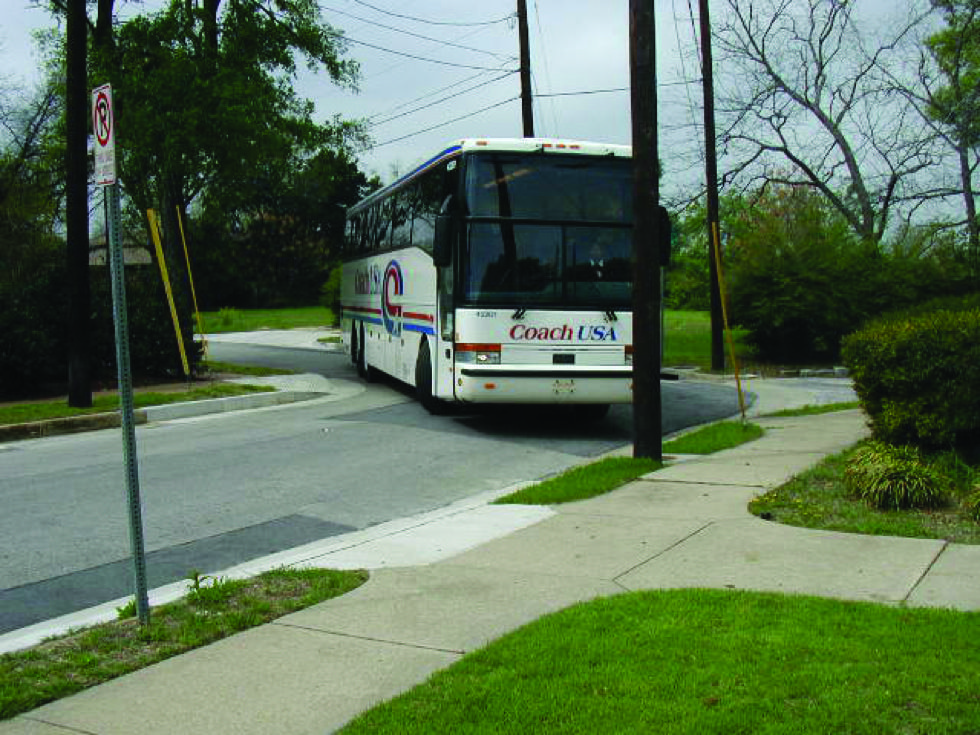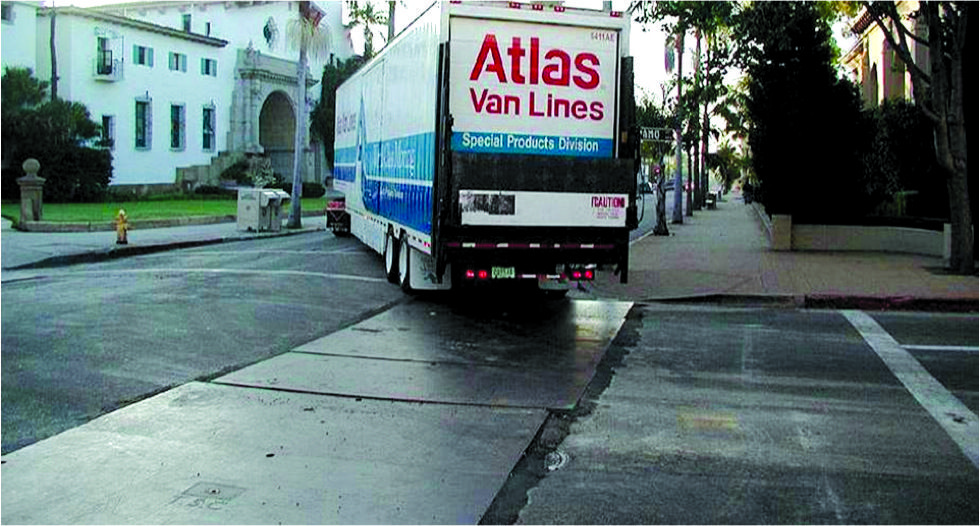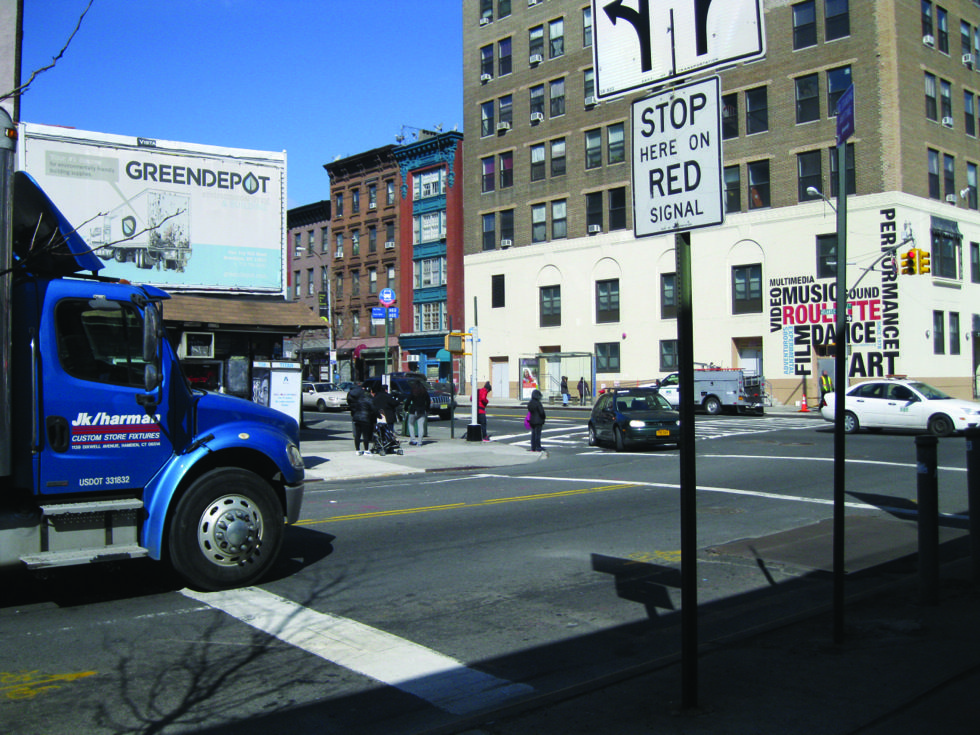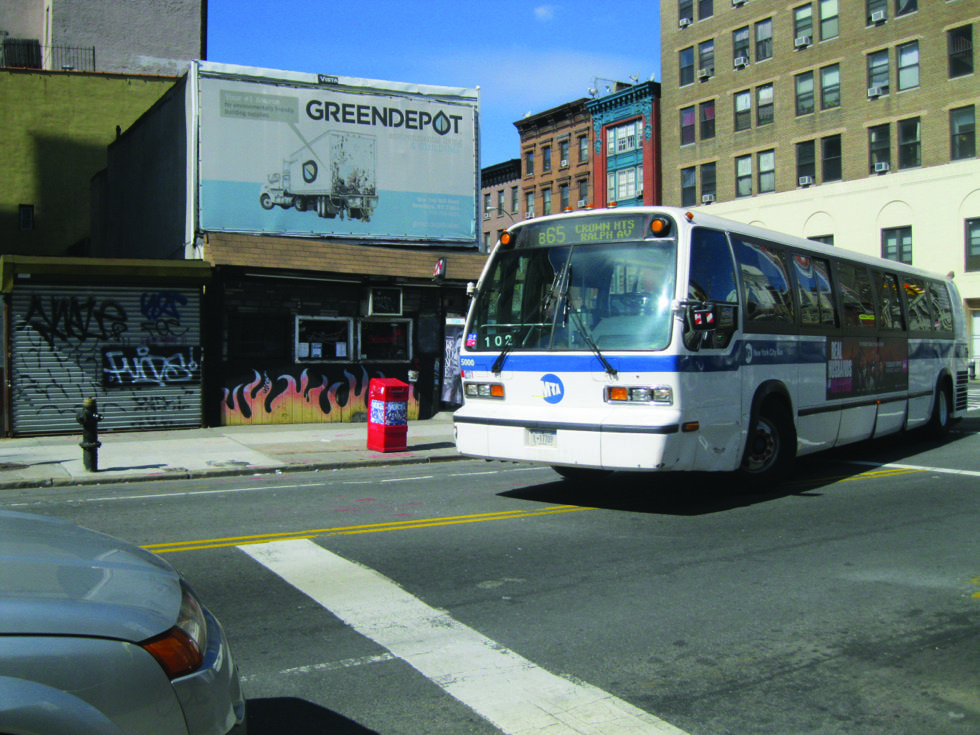Design Vehicle
Design for the most vulnerable street user rather than the largest possible vehicle. While designs must account for the challenges that larger vehicles, especially emergency vehicles, may face, these infrequent challenges must not dominate the safety or comfort of a site for the majority of daily users.
The selection of design vehicle influences the physical characteristics, safety, and operations of a roadway.
Discussion
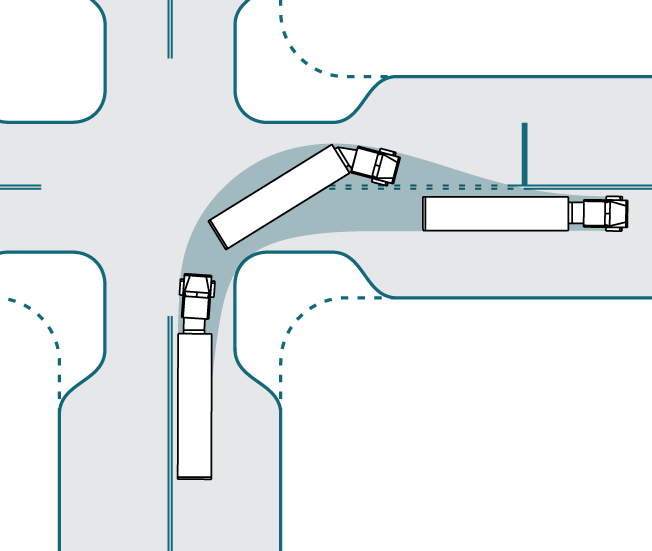 Allowing infrequent vehicles to use the whole intersection (moving left slightly before the turn and using the lane adjacent to the right lane on the receiving side) allows the entire intersection to become more compact, reducing turning speeds of regular vehicles to 12–15 mph. A recessed stop bar prevents conflicts with opposing traffic.
Allowing infrequent vehicles to use the whole intersection (moving left slightly before the turn and using the lane adjacent to the right lane on the receiving side) allows the entire intersection to become more compact, reducing turning speeds of regular vehicles to 12–15 mph. A recessed stop bar prevents conflicts with opposing traffic.
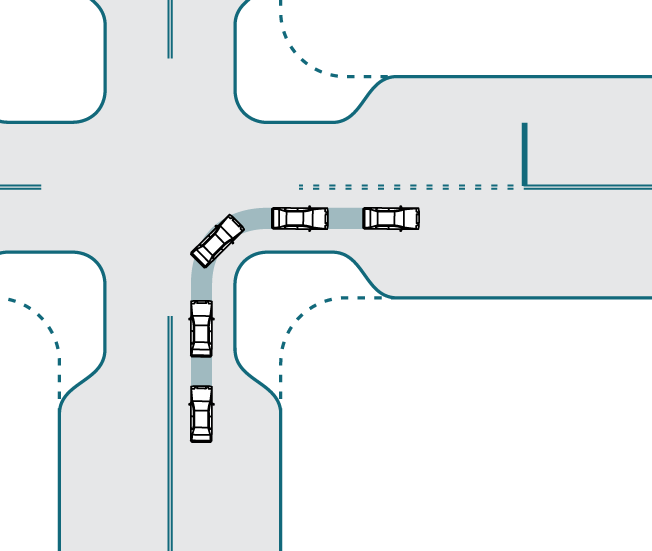 Using a smaller design vehicle but allowing for occasional larger vehicles to use the entire intersection allows the design to promote a typical turning speed of 5–10 mph.
Using a smaller design vehicle but allowing for occasional larger vehicles to use the entire intersection allows the design to promote a typical turning speed of 5–10 mph.
Critical
The design vehicle types below should be considered in order to maintain property access while emphasizing pedestrian safety and low speeds.
Street Type
Design vehicle
Neighborhood and Residential Streets
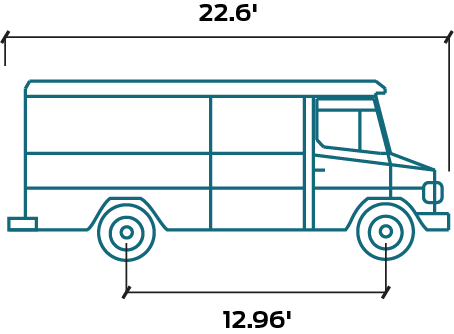
Downtown and Commercial Streets

Designated Truck Routes
Note: Trucks are permitted to use the full intersection when making turns onto a receiving street.

Designated Bus Routes
Note: Buses are permitted to use the full intersection when making turns onto a receiving street, but this is not preferable on a full-time bus route if it can be avoided.

Optional
Recommended
 Location: Chicago, IL - This truck is an example of the DL-23.
Location: Chicago, IL - This truck is an example of the DL-23.
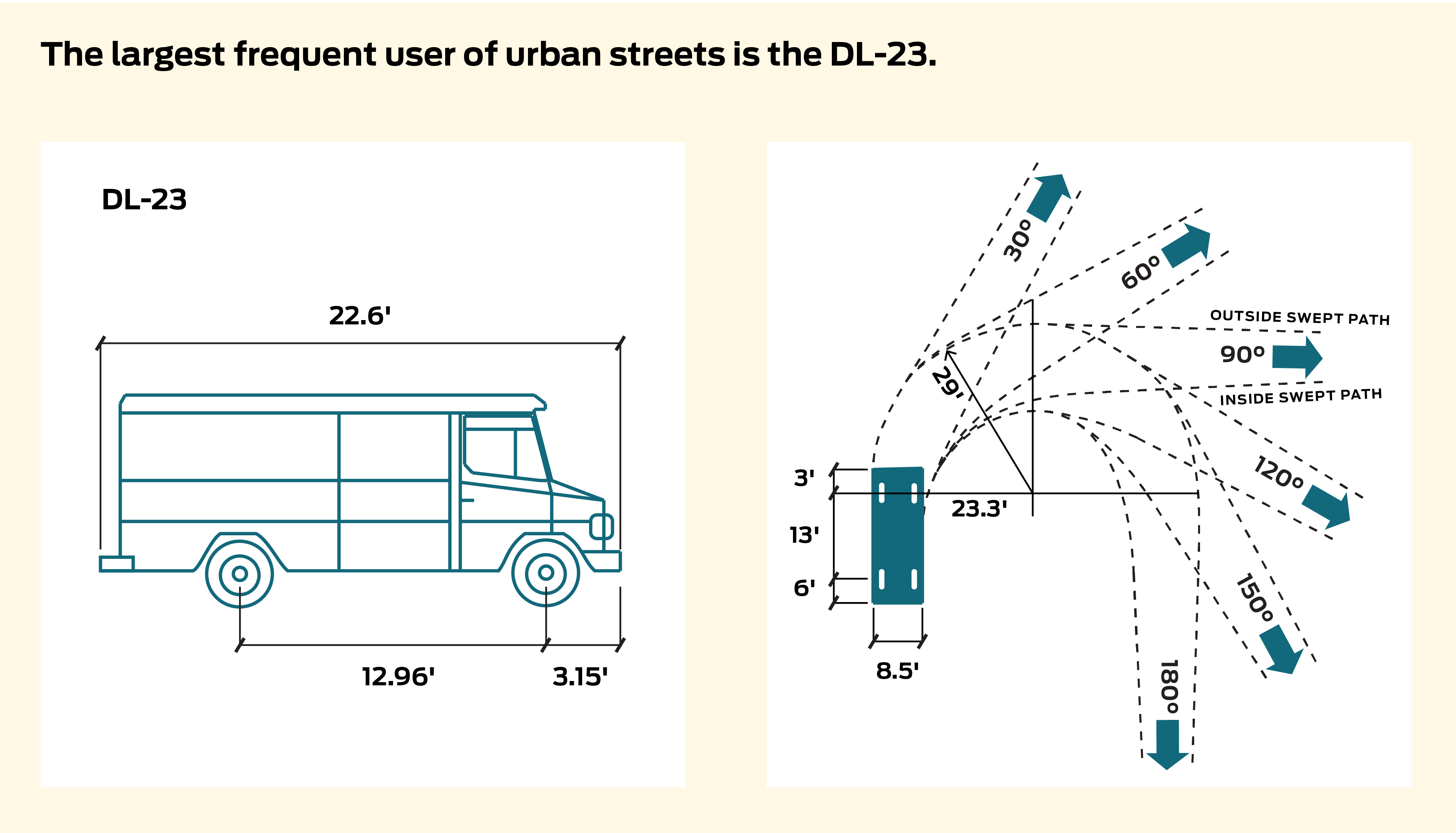 Portland’s freight master plan classified truck routes and created freight districts.8
Click to enlarge.
Portland’s freight master plan classified truck routes and created freight districts.8
Click to enlarge.
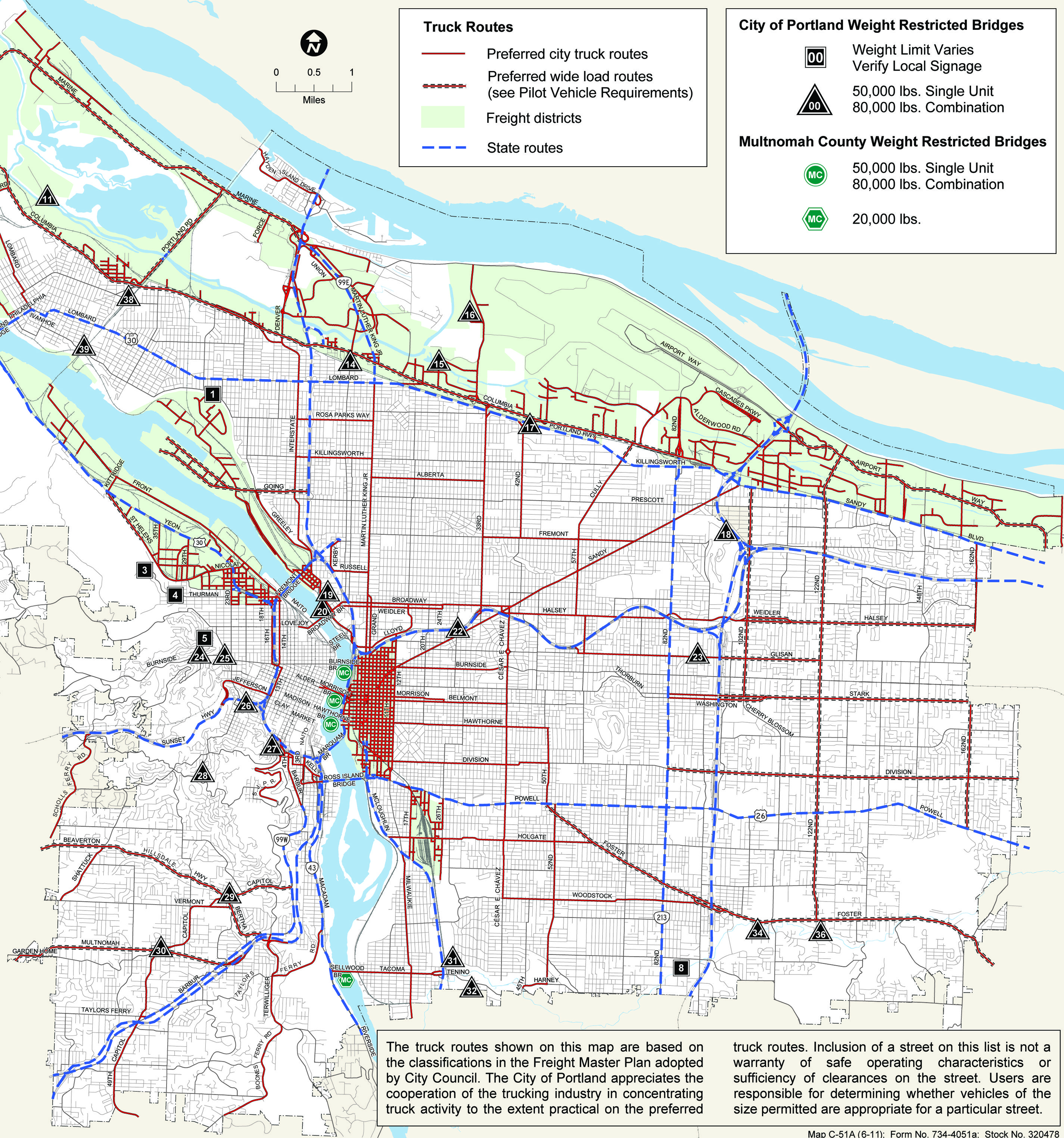 Click to enlarge.
Click to enlarge.
Footnotes
- A Policy on Geometric Design of Highways and Streets, (Washington, D.C.: AASHTO, 2011), Section 2-1.
- Kendra K. Levine, Curb Radius and Injury Severity at Intersections (Berkeley: Institute of Transportation Studies Library, 2012).
- Most state vehicle codes stipulate that drivers should turn right “as close as practical” to the right-hand curb or edge of the roadway. “Practical” is not defined and code does not ban use of multiple lanes to complete a turn if needed. For example, see:
Illinois General Assembly, “625 ILCS 5/ Illinois Vehicle Code,” Illinois Compiled Statues (Springfield).
- Curb extensions can improve emergency vehicle access by keeping the intersection clear of parked cars.
FHWA Safety Program, “Traffic Calming,” accessed June 3, 2013.
Emergency vehicle codes require ambulances and fire trucks to slow down at intersections and remain alert for other users. For example, see:Illinois General Assembly, “625 ILCS 5/ Illinois Vehicle Code, Section 11-205,” in Illinois Compiled Statues (Springfield).
In Pennsylvania, ambulances are specifically required to comply with stop signs and red lights.Pennsylvania Department of Motor Vehicles, “Vehicle Code— Chapter 31,” (Harrisburg), 2.
Dan Burden and Paul Zykofsky. “Emergency Response: Traffic Calming and Traditional Neighborhood Streets,” (Sacramento: The Local Government Commission Center for Livable Communities, 2001).
Ryan Snyder et al. “Best Practices: Emergency Access in Healthy Streets,” (Los Angeles: Los Angeles County Department of Public Health, 2013).
- Currently, many cities use SU-30 as the design vehicle on non-truck routes. For example, see:
“Design Criteria,” Seattle Right-of-Way Improvements Manual (Seattle: City of Seattle, 2012).
- Low “crawl” speeds are referenced by Flexibility in Highway Design, (Washington, D.C.: U.S. Dept. of Transportation, Federal Highway Administration, 1997).
- In New York City, approximately 10% of pedestrian injuries occur at “off-road” locations such as on sidewalks or inside buildings.
Transportation Alternatives, “1,200 NYC Pedestrians Struck On Sidewalks Every Year,” accessed June 3, 2013.
References
- American Association of State Highway and Transportation Officials. A Policy on Geometric Design of Highways and Streets. Washington, D.C.: 2001.
- Burden, Dan, and Paul Zykofsky. “Emergency Response: Traffic Calming and Traditional Neighborhood Streets.” Sacramento: The Local Government Commission Center for Livable Communities, 2001.
- City of Seattle. “Chapter 4: Design Criteria.” Seattle Right-of-Way Improvements Manual. Seattle: 2012.
- Federal Highway Administration. “Traffic Calming.” Accessed June 3, 2013.
- Festini, Andrea, Andrea Tonoli, and Enrico Zenerino. “Urban and Extra Urban Vehicles: Re-thinking the Vehicle Design.” New Trends and Developments in Automobile System Engineering (2011): 1-17.
- Harwood, Douglas W., Darren J. Torbic, Karen R. Richard, William D. Glauz, and Lily Elefteriadou. “Review of Truck Characteristics as Factors in Roadway Design.” Transportation Research Board NCHRP Report 505 (2003): 1-194.
- Illinois General Assembly. “625 ILCS/Illinois Vehicle Code.” Illinois Compiled Statues, Springfield.
- Levine, Kendra. “Curb Radius and Injury Severity at Intersections.” Institute of Transportation Studies Library, University of California, Berkeley, 2012.
- Pennsylvania Department of Motor Vehicles. “Vehicle Code – Chapter 31.” Operation of Vehicles.
- Portland Office of Transportation. Designing for Truck Movements and other Large Vehicles in Portland. Portland: 2008.
- Portland Office of Transportation. Freight Master Plan. Portland: 2006.
- Snyder, Ryan et al. “Best Practices: Emergency Access in Healthy Streets.” Los Angeles: Los Angeles County Department of Public Health, 2013.
- Transport for NSW. “Vehicle Standards Information.” Supersedes (2012): 4(5), 1-20.
- Transportation Research Board. “Commercial Truck and Bus Safety: Highway/Heavy Vehicle Interaction.” Transportation Research Board Synthesis 3 (2003): 3-28.
- U.S. Department of Transportation. “Flexibility in Highway Design.” U.S. Department of Transportation, Federal Highway Administration, 1997.
- Washburn, Scott. “Design Vehicles and Turning Radii.” Brazhuman Corp, 1-19.
Adapted from the Urban Street Design Guide, published by Island Press.
References
References for Design Vehicle: 15 found.
- Illinois General Assembly. "625 ILCS/Illinois Vehicle Code." Illinois Compiled Statutes, State of Illinois, Springfield, IL.
- American Association of State Highway and Transportation Officials. "A Policy on Geometric Design of Highways and Streets." American Association of State Highway and Transportation Officials, American Association of State Highway and Transportation Officials, Washington, DC.
- Snyder, Ryan, Patrick Siegman, Herbie Huff, & Cullen McCormick. "Best Practices: Emergency Access in Healthy Streets." Transportation Planning for Livable Communities, Los Angeles County Department of Public Health, Los Angeles, CA.
- Harwood, Douglas W, Ingrid B Potts, Darren J Torbic, & William D Glauz. "Commercial Truck and Bus Safety: Highway/Heavy Vehicle Interaction." CTBSSP Synthesis 3, 3-28, Transportation Research Board, Washington, DC.
- Levine, Kendra. "Curb Radius and Injury Severity at Intersections." Institute of Transportation Studies Library, University of California, Berkeley, CA.
- Washburn, Scott. "Design Vehicles and Turning Radii." TTE 4824, Brazhuman Corp, São Paulo.
- Garber, Sorin, Chuck Green, Patrick Sweeney, & Christopher Hemmer. "Designing for Truck Movements and other Large Vehicles in Portland." Office of Transportation, City of Portland, Portland, OR.
- Burden, Dan & Zykofsky, Paul. "Emergency Response: Traffic Calming and Traditional Neighborhood Streets." Local Government Commission, Center for Livable Communities, Sacramento, CA.
- Institute of Transportation Engineers. "Traffic Calming." Office of Safety Programs, Federal Highway Administration, Washington, DC.
- US Department of Transportation. "Flexibility in Highway Design." Federal Highway Administration, US Department of Transportation, Washington, DC.
- Pennsylvania Department of Transportation. "Vehicle Code – Chapter 31: Operation of Vehicles." Pennsylvania Department of Transportation, Harrisburg, PA.
- Harwood, Douglas W, Darren J Torbic, Karen R Richard, William D Glauz, & Lily Elefteriadou. "Review of Truck Characteristics as Factors in Roadway Design." NCHRP Report 505 1-194, Transportation Research Board, Washington, DC.
- City of Seattle. "Seattle Right-of-Way Improvements Manual, Ch. 4: Design Criteria." Department of Transportation, Department of Planning and Development, Public Utilities, City Light, Parks and Recreation, Fire Department, & Department of Neighborhoods , City of Seattle, Seattle, WA.
- Festini, Andrea, Andrea Tonoli, & Enrico Zenerino. "Urban and Extra Urban Vehicles: Re-thinking the Vehicle Design." New Trends and Developments in Automobile System Engineering, InTech, Rijeka.
- Transport for NSW. "Vehicle Standards Information." Transport for NSW, New South Wales Government, Haymarket, NSW.


